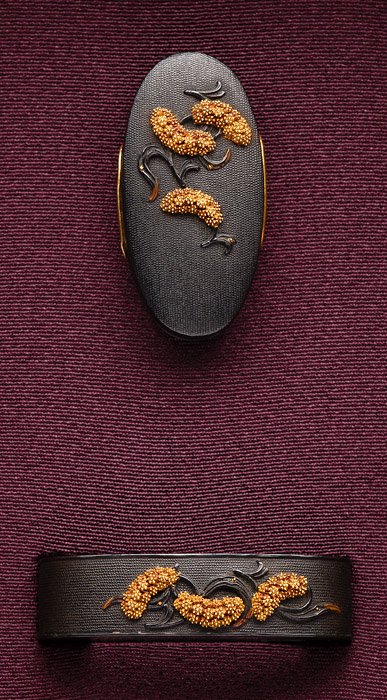Archived Nihonto.ca (Yuhindo.com): Araki Tomei
Araki Tomei
| period: | Late Edo (ca. 1850) |
| designation: | NBTHK Tokubetsu Hozon Tosogu |
| mei: | 吟枩亭東明 Ginshotei Tomei (kao) |
| form: | Fuchigashira featuring millet in gold and shakudo |
| price: | N/A |
Goto Ichijo is likely one of the top three soft metal artisans of Japanese history, and certainly of the late Edo period. He shook the moribund style of the Goto main line out of its stasis and introduced new styles and materials which established his place in history as an innovator. Ichijo took commissions from the Emperor and was a house artist for the Tokugawa shogun. His artistic sense in my opinion is second to none, and his works never cease to amaze. Ichijo had many extremely skilled students who are considered among the grand masters of the time, indicating his own prowess as a teacher and his fame in his time as he attracted talented men to his circle.
Goto Ichijo began working in shibuichi, an alloy of silver and copper, after mastering the shakudo and gold house style of Goto. He reached the peak of his skill in this material, which carried forward into his use of iron which followed. Shibuichi makes a beautiful background material as in high grades it contains subtle texture, and provides good contrast for silver, gold and shakudo inlay, as well as good contrast for carvings.
Goto Ichijo taught several master students, and probably the most famous of them is Araki Tomei (荒木東明). Tomei was the son of a rice dealer named Yohei and born in Kyoto in 1817 with the personal name Honoshin.
Due to some interesting Japanese traditions, Honoshin having been born in the year of the Ox was unable to inherit the family rice business due to a custom of giving sons away born in this year to other families. His brother Yataro ended up inheriting the business, and Tomei went on at the age of 13 to apprentice under Goto Tojo Kosetsu (8th master of the Goto Kanbei line) as a kinko artist under and received the name Hidenobu to begin with.
As his apprenticeship progressed Goto Tojo gave him the first character of his own name, and he began signing work at this point as Tomei. Soon after he took up training with Goto Ichijo and received an additional name Issai, containing the first character of Ichijo’s name. This was a habit of Ichijo and permitted all of his main students the use of the Ichi character. Tomei would use this name on occasion in combination with Tomei in signing, unlike some of Ichijo’s other students who adopted their new name wholesale. Instead, he never abandoned the Tomei name. Mostly even after studying with Ichijo Tomei used the additional art name Ginshotei in front of Tomei, and also Shogintei, and together it’s thought that Tomei felt great appreciation for Goto Tojo and retained his gifted art name as a result.
During the period of his independence Tomei opened a shop at Yanagibajo dori in Kyoto. He also became friends with Hayashi Ranga (林 蘭雅) who was a famous painter, and he took up training in this art. He’s thought to have somehow during this episode come up with the knowledge for carving special millet heads which are found on the popular form of his work. To make these he designed and fabricated his own chisels, and the combination of chisel and technique has not been duplicated to this day. This design became very popular and remains popular due to their intricate beauty and today are very expensive though they are somewhat interchangeable.
Tomei worked mostly in sold gold and shakudo, but also worked on shibuichi and iron ground (which were innovations brought about by his teacher Ichijo).
Tomei died fairly young at 54 years old in 1870. The work he left to us today is highly sought after by collectors and has risen to Juyo and even Tokubetsu Juyo levels. By my count there are currently 23 items Juyo and higher, and one of these is Tokubetsu Juyo. All of them follow the theme of millet.
Tokubetsu Hozon Tomei Fuchigashira
This fuchigashira is made by Tomei in his famous theme of millet. It’s difficult to find these for sale due to their popularity, and sometimes the prices are extremely high. The millet heads are solid gold, with the ground in shakudo.
Tomei signed these with his typical name Ginshotei Tomei. They are signed in the style of Goto Ichijo with sparse file marks as can be found on the work of his top students.
The work is very beautiful and suitable for any collection, as they are instantly identifiable and an archetype of kinko kodogu from the late Edo period.
They come in a box which has an old confirmation of the authenticity of the work by Kuwabara Yojiro. It reads:
- 荒木東明作Araki Tômei saku
- 粟穂図赤銅縁頭Awaho no zu shakudô fuchigashiraShakudô fuchigashira depicting millet heads
- 東明は一類粟穂の鑚を工夫せしふより粟穂の彫刻は他工の模倣と容ぎる特色あるものなりTômei wa ichirui awaho no horu o kôfu-seshiu yori awaho no chôkoku wa takô no mohô to yôgiru tokushoku aru mono nariTômei developed unique millet head carvings which distinguish themselves from the interpretations of other artists.
- 昭和十二年五月Shôwa jûninen gogatsuMay 1937
- 中央刀剱会審査員Chûô Tôken Kai Shinsa’inShinsa member for the Chûô Tôken Kai
- 桑原雙蛙Kuwabara SôwaKuwabara Sôwa [Yôjirô]
Kuwabara Yojiro was an expert on Goto work and a collector of paintings as well as sword fittings and wrote some reference works still in use today. He lived in the late 1800s and early 1900s and advised Alexander Mosle on sword fittings. Mosle went on to introduce sword fittings to the west and his presentation to the Japan Society in London was recorded and remains very interesting. Yojiro’s hakogaki is a nice bonus to the set.


